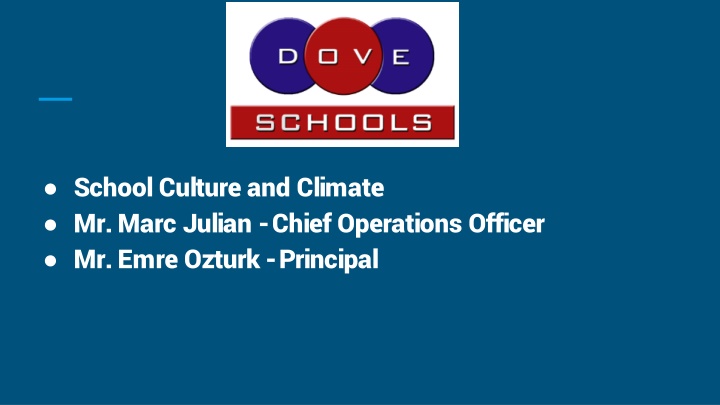
School Culture and Climate for Effective Leadership
Explore the critical components of school culture and climate such as vision, communication, consistency, and leadership to foster a positive and effective learning environment. Learn how to establish clear communication, maintain consistency, and cultivate a strong school culture. Discover the key role of school leaders in shaping and maintaining a conducive educational setting.
Download Presentation

Please find below an Image/Link to download the presentation.
The content on the website is provided AS IS for your information and personal use only. It may not be sold, licensed, or shared on other websites without obtaining consent from the author. If you encounter any issues during the download, it is possible that the publisher has removed the file from their server.
You are allowed to download the files provided on this website for personal or commercial use, subject to the condition that they are used lawfully. All files are the property of their respective owners.
The content on the website is provided AS IS for your information and personal use only. It may not be sold, licensed, or shared on other websites without obtaining consent from the author.
E N D
Presentation Transcript
School Culture and Climate Mr. Marc Julian -Chief Operations Officer Mr. Emre Ozturk -Principal
School Culture and Climate Clear Vision and Mission Communication Consistency Stages: Creating, Building, Maintaining, Correcting
Vision and Mission What is the vision/mission/purpose of the district, school, program? Is it clearly stated? Is it understood by all stakeholders? How do we check? How do we teach it to new students, parents, faculty? What is the buy-in among stakeholder groups? Is there a meaningful process and effort to resolve stakeholder dissatisfaction?
Communication How do we establish and maintain clear lines of communication? How do we ensure it is two-way communication that includes all stakeholders? What do we do when communication breaks down? How do we reach the unreachable?
Consistency Do we stick to the vision, mission, purpose? Do we align our efforts/resources accordingly? Do we follow through on the goals we set? How do we make sure climate/culture build from year to year? Change is inevitable. When things do change, how do we communicate it clearly to all stakeholders in positive, yet honest messaging?
Culture Culture is the most powerful source of leverage for bringing about change in a school for that matter (Thomas Sergiovanni) Tells people what is truly important Tells people how they are to act Norms Beliefs Values Ceremonies Symbols Stories
School Leaders are the key Effective school leaders... - - - - Communicate regularly to exhibit a positive outlook Are passionate about their work Accept responsibility for the school culture Are organized
Every School has: - A formal culture (job descriptions, traditions, mission, vision and symbols(school mascot, song)) An informal culture -how people interact with each other, share information, how work gets done and by whom -
The Markers of School Culture - - - - - The mission statement Student programs Programs for teachers The physical building Learning environments
School culture can - - - - - Unify people within the school and its many communities. Assist with establishment of a plan for school improvement Focus people on the future and point to what the school wants to become Promote growth in the folks who work there Teacher and administrators share their knowledge and develop plans together to achieve organizational goals.
School Culture vs School Climate - - School culture is over a period of time the history School climate is now, it s the perceptions/emotions being evoked
School Climate - School climate is the communication of its norms, beliefs, and values through various behaviors and interactions and their effect on others, with the primary focus being on students. School climate is the social atmosphere in which people interact with others and the school environment. Examples: The quality of interactions in the teacher s lounge The noise levels in the hallways and cafeteria How safe people feel - - - -
School Climate School cultures and positive climates do not magically occur! Teamwork, experiences, appreciation, recognition, caring and celebration are key factors of school culture and climate.
Unhealthy School Cultures Ineffective school leaders... Are rarely seen outside of their offices. Spend little time on communication. Feel that other people are responsible for their school s needs. See themselves as the lone leader or boss of the school. Never empower teachers to lead.
Why is school culture/climate important? - Positive teaching/learning can only take place in a positive culture/climate. A healthy school culture/climate will affect more student and teacher success than any other reform or school improvement effort currently being employed. -Gary Phillips


















